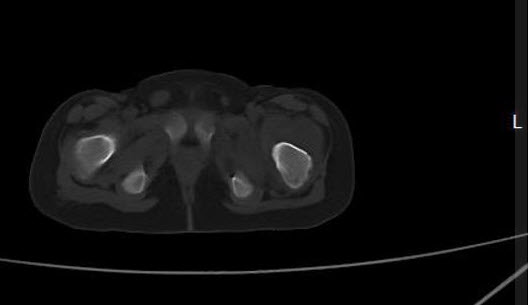Osteomyelitis CT
|
Osteomyelitis Microchapters |
|
Diagnosis |
|---|
|
Treatment |
|
Case Studies |
|
Osteomyelitis CT On the Web |
|
American Roentgen Ray Society Images of Osteomyelitis CT |
Editor-In-Chief: C. Michael Gibson, M.S., M.D. [1]; Associate Editor(s)-in-Chief: Seyedmahdi Pahlavani, M.D. [2]
Overview
CT scan can demonstrate osseous and soft-tissue abnormalities and is ideal for detecting gas in soft tissues. Bones such as the sternum, vertebrae, pelvic bones, and calcaneus are far better imaged with a CT scan than with plain radiographs.
CT Scan
CT scan is usually more readily available for establishing the diagnosis especially in emergencies.[1] In selected children who cannot remain still or tolerate sedation, CT is a valuable imaging modality. CT scan findings may include the following:
- Overlying soft-tissue swelling, periosteal reaction, medullary low-attenuation areas or trabecular coarsening, and focal cortical erosions.
- Osseous and soft-tissue abnormalities and is ideal for detecting gas in soft tissues.
Bones such as the sternum, vertebrae, pelvic bones, and calcaneus are far better imaged with a CT scan than with plain radiographs. - CT is most commonly used to detect and to define areas of possible infection in bones with complex anatomy that is difficult to visualize on plain radiographs and bone scans.[2]
The following imaging series demonstrate little infectious nidus of the left femoral neck, synovitis, soft tissue mass (abscess), sequestrum and periosteal reaction in a 4 years old boy with acute hematogenous osteomyelitis of left femur.
References
- ↑ Laura M. Fayad, John A. Carrino, and Elliot K. Fishman. Musculoskeletal Infection: Role of CT in the Emergency Department. RadioGraphics 2007 27: 1723-1736.
- ↑ Pineda C, Vargas A, Rodríguez AV (2006). "Imaging of osteomyelitis: current concepts". Infect. Dis. Clin. North Am. 20 (4): 789–825. doi:10.1016/j.idc.2006.09.009. PMID 17118291.






